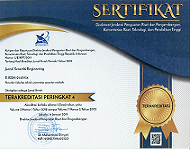Pengujian Model Fondasi Kacapuri dengan Penambahan Strip Plat Kayu Ulin di Tanah Gambut
Keywords:
fondasi kacapuri, pengujian pembebanan, strip plat kayu ulin, tanah gambutAbstract
The distribution of peat soils with high organic content in the Kalimantan region causes low soil bearing capacity and large soil settlement, which adversely affects construction projects. Local communities commonly use kacapuri foundations made from a combination of ironwood and galam wood, but these foundations are not fully effective in resisting loads. This research modifies the foundation by adding ironwood plate strips modelled through the Plaxis 2D program and continued with prototyping in the laboratory by providing loading tests. The data used is primary data from laboratory testing with soil samples taken from the location on Bondang Street, Palangka Raya City. Laboratory testing of the physical and mechanical properties of peat soil revealed a moisture content = 580.51%, volume weight = 1,06 g/cm3, specific gravity = 1.79, ash content = 4.65%, fibre content = 33.12%, cohesion = 0,0023 kg/cm2, inner shear angle = 1.8856°, shear stress from the normal stress and shear stress relationship graph = 0.006 and soil shear strength in the range of 0.0064 - 0,0174 kg/cm2. The modelling that has been done provides a modification with four strips of ironwood plate. The prototype made produces a decrease value according to SNI 8460: 2017 standard which is 2.5 cm in the Plaxis experiment the required load is smaller than in the laboratory. In Plaxis, a large load of 356.9 kg is required to achieve settlement, and a load of 380 kg is required in the laboratory settlement test.
References
[1]American Society for Testing and Materials. (2023). “Standard Classification of Peat Samples by Laboratory Testing”. ASTM D4427-23, ASTM International, West Conshohocken, PA.
[2] Agus, F., dan Subiksa, I. M. (2008). Lahan gambut: Potensi untuk pertanian dan aspek. Balai Penelitian Tanah dan Word Agroforestry Centre (ICRAF), Bogor, 36.
[3] Badan Standarisasi Nasional. (2017). SNI 8640:2017 Persyaratan Perancangan Geoteknik. Jakarta: BSN.
[4] Das, B. M. (1985). Mekanika Tanah-Prinsip-Prinsip Rekayasa Geoteknis, Jilid 1, 2, Terjemahan oleh Noor Endah Mochtar, Ir., M. Sc (Doctoral dissertation, Ph. D, dan Indra Surya B. Mochtar, Ir., M. Sc., Ph. D. Principles of Geotecnical Engineering, Penerbit Erlangga, Jakarta).
[5] Harwadi, F. dan Mochtar, N.E., 2010. Compression Behavior of Peat Soil Stabilized with Environmentally Friendly Stabilizer. In: Proceedings of the First Makassar International Conference on Civil Engineering (MICCE2010). pp.9–10.
[6] Hedliansyah, J.C., Ma’ruf, M.A., dan Krasna, W.K. (2014). “Inovasi Desain Pondasi Kacapuri di Atas Tanah Gambut yang Distabilisasi”. Jurnal LANTING (Journal of Architecture), Vol.3, No.1, Universitas Lambung Mangkurat, Kalimantan Selatan.
[7] Iskandar, I., 2000. Tinjauan Kapasitas Dukung Teoritis Fondasi Kacapuri. INFOTEKNIK, 1(1), pp.13–21.
[8] Lahabu, D., Faisal, A. and Bacthiar, V., 2021. STUDI KARAKTERISTIK KOMPRESIBILITAS TANAH GAMBUT DI KOTA PONTIANAK MENGGUNAKAN ALAT UJI ROWE CELL. JeLAST: Jurnal PWK, Laut, Sipil, Tambang, 8(2).
[9] Landva, A.O., P. La Rochelle, dan P.M. Jarrett, ed., 1982, "Compressibility and Shear Characteristics of Radforth Peats", Testing of Peats and Organic Soils, ASTM, STP. 820
[10] Lesmana, R. (2022). “Identifikasi Kenampakan Fisik Tanah Gambut (Peat Soil) di Kelurahan Tanjung Selor Timur Kabupaten Bulungan Provinsi Kalimantan Utara”. Jurnal Pendidikan Tambusai, Vol.6, No.3, pp.13688-13693.
[11] MacFarlane, I.C., 1969. Engineering characteristics of peat. Muskeg engineering handbook, pp.78–126.
[12] Mochtar, N.E. dan Yulianto, F.E. (2014). “Pengaruh usia stabilisasi pada tanah gambut berserat yang distabilisasi dengan campuran CaCO3 dan pozolan”. Jurnal Teknik Sipil ITB, Vol.21, No.1, pp.57–64.
[13] Nugroho, S.A., 2011. Studi Daya Dukung Pondasi Dangkal pada Tanah Gambut dengan Kombinasi Geotekstil dan Grid Bambu. Jurnal Teknik Sipil ITB, 18(1), pp.31–40.
[14] Nurfansyah, N., Saud, M.I., Wastuti, P.W., Aini, A.Q. dan Agusniansyah, N. (2020). “Perkembangan Pondasi Tiang Kayu Pada Rumah Tinggal Di Banjarmasin”. Info-Teknik, Vol.21, No.2, pp.199–214.
[15] Seman, S. dan Irhamna, (2006). “Arsitektur tradisional Banjar, Kalimantan Selatan”. Lembaga Pengkajian dan Pelestarian Budaya Banjar, Kalimantan Selatan.
Downloads
Published
Issue
Section
License
Copyright (c) 2025 Stephanus Alexsander, Fatma Sarie, Liliana, Ayu Rosaulina Sinaga (Author)

This work is licensed under a Creative Commons Attribution 4.0 International License.












